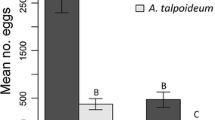Abstract
Bay scallops (Argopecten irradians concentricus) are patchily distributed on two dominant spatial scales: (1) geographically restricted to highly saline marine lagoons, and (2) locally abundant within such lagoons only in relatively discrete beds of seagrass habitat. In the Cape Lookout lagoonal system of North Carolina, adult bay scallop abundance in the most densely occupied seagrass bed (Oscar Shoal) exhibits repeatable declines from up to 70 m–2 to near zero in a 2- to 4-week period during late summer. This crash is completed before fall spawning can be initiated, thereby creating a population sink in what is the singly most productive patch of habitat. Field experiments conducted in the summers of 1996 and 1998 demonstrated that the seasonal extinction of bay scallops on Oscar Shoal can be prevented by the erection of 1-m2 stockades, made of 50-cm-high vertical poles, spaced every 25 cm, which inhibit access by cownose rays. Because these stockades were porous to emigration and physical transport, and open to access by all other predators of adult scallops, predation by migrating cownose rays is the only viable explanation for the crash. Consequently, the natural predation process in this system achieves the reproductive extinction of prey in the habitat patch of highest productivity. Over 7 years of observation, the mortality rate in this patch increased with summer density, reaching the asymptote of 100% at 10 m–2. The site-specific habitat selection by schools of rays may be based on prey density, which could render this example representative of a widespread generator of population sinks in habitat patches of high quality. The virtual extinction of scallops within Oscar Shoal despite nearby patches with relatively high density may be related to the highly efficient feeding behavior of schools and the high vulnerability of bay scallops in a context of multiple alternative prey types.
Similar content being viewed by others
Author information
Authors and Affiliations
Additional information
Electronic Publication
Rights and permissions
About this article
Cite this article
Peterson, C.H., Fodrie, J.F., Summerson, H.C. et al. Site-specific and density-dependent extinction of prey by schooling rays: generation of a population sink in top-quality habitat for bay scallops. Oecologia 129, 349–356 (2001). https://doi.org/10.1007/s004420100742
Received:
Accepted:
Published:
Issue Date:
DOI: https://doi.org/10.1007/s004420100742




